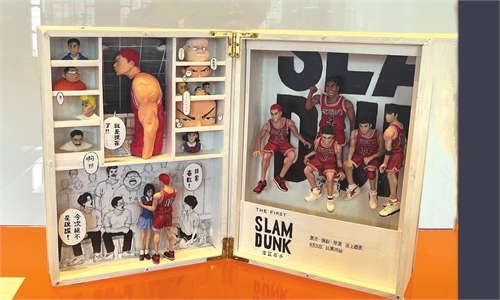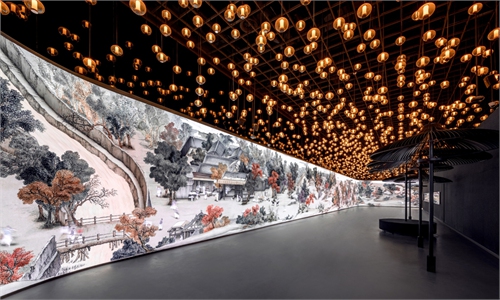ARTS / CULTURE & LEISURE
Contemporary evolution of ink painting and futuristic experiment of ‘ink sculpture’
Editor's Note:
Chinese ink painting, a centuries-old art using ink and brushwork, has influenced and inspired global art. For Chen Hongyi, director of the Minsheng Art Museum and Minsheng Calligraphy Museum, ink painting is not just a medium but also a cultural gene that can convey Chinese inner emotions. In this article, Chen elaborates on innovative concepts such as ink sculpture and dissects his interpretation of ink wash art in painting, blending theoretical depth with practical application.

Chen Hongyi
As an artist deeply engaged in the traditions of Chinese ink painting, my practice has always been rooted in the cultural depth of this art. Yet, I have sought to expand its boundaries, to translate its essence into a contemporary language that challenges the constraints of tradition while remaining faithful to its origins. My "ink sculpture" concept represents this effort: It is not merely a technical experiment but an exploration of how ink painting, as a cultural gene, can evolve into a global, multidimensional language.While my studies were grounded in Chinese ink painting, my early training in Western sketching and oil painting provided a solid technical foundation that later informed my approach to blending realism and abstraction. This interdisciplinary academic background gave rise to the core idea that "ink painting is not only a medium but also a cultural gene," and also laid the foundation for my later proposal of the "ink sculpture" theory.
Early style: Multidimensional reconstruction
My early works were largely devoted to traditional flower-and-bird themes, particularly the "Four Gentlemen in Chinese paintings"- plum, orchid, bamboo, and chrysanthemum. These subjects are deeply embedded in traditional Chinese literati culture, representing virtues such as resilience, grace, and integrity.
Then I began experimenting with mixed media, layering materials like mineral pigments, acrylics, and textured brushstrokes to create works with a sculptural quality. This approach marked the early stages of what I call "ink sculpture." In the Hequ (lit: Lotus delights) series, for example, I used ink wash to render the softness of lotus leaves while employing dry-brush techniques to depict the roughness of lotus seed pods.
The result was a relief-like texture that retained the ethereal spirit of ink but added a physical weight to the objects depicted.

A paintings of an angel by Chen Hongyi Photo: Courtesy of Chen Hongyi
Contemporary translation: The methodology of 'ink sculpture'Central to my practice is a commitment to the "subjectivity of Eastern aesthetics." The depictions of lotus flowers and bamboo rocks transcend mere representations of natural objects, serving instead as contemporary reinterpretations of cultural symbols such as "nobility" and "resilience."
The "ink sculpture" concept deconstructs and reassembles the "bone method" of Chinese brushwork with the sense of volume, and light and shadow of Western art. This method reflects a dialogue between cultural self-awareness and global discourse.
This "deconstruction-reconstruction" approach continually expands the boundaries of ink painting as a medium.
Recent works, such as Nanfang Zengzhang Tianwang (lit: The Southern King of Growth) and Longma Jingshen (lit: Spirit of dragon and horse), represent significant milestones in the evolution of the "ink sculpture" system, exploring the coexistence of the material and digital.
The painting Nanfang Zengzhang Tianwang reinterprets the traditional Buddhist guardian deity, breaking away from the symmetrical solemnity of classical iconography. Inspired by the idea of "cross-sectional scanning," the figure is divided into contrasting halves: the left side retains the refined shading of Tang and Song dynasties (618-907, 960-1279) gongbi techniques, while the right side transforms into a mechanistic, titanium-like texture created through aluminum foil stamping. By incorporating cyber-mechanical motifs, such as circuit board-like armor patterns, I sought to symbolize the dual flow of Buddhist traditions Eastward and technological advancements Westward.
Longma Jingshen takes renowned Chinese painter Xu Beihong's Galloping Horse as its reference framework. Using motion capture technology, the acceleration of wrist movements while painting can be recorded, then these data points can be converted into the curvature and density of resin components. The horse's mane, inspired by the minimalist strokes of Chinese painter, calligrapher and poet Bada Shanren was rendered in 3D-printed fragments, creating a "flying white" effect (a style of calligraphy characterized by hollow strokes).

A paintings of a tiger by Chen Hongyi Photo: Courtesy of Chen Hongyi
Ink in the age of AI: A meta-languageIn 2023, at Tsinghua University's Art and Science Forum, I proposed that "the algorithmic essence of ink lies in the codification of Eastern philosophy." This idea has been central to the recent project Mobian Jihua (lit: The ink metamorphosis), developed in collaboration with the MIT Media Lab. For the first time, I translated the random diffusion of ink on xuan paper into an AI deep learning model.
In the 2024-piece Hundun Chukai (lit: Primordial chaos), AI-generated diffusion pathways interact with hand-drawn frameworks, creating a dynamic interplay between control and randomness. Each ink stain on the paper was the result of a GAN (Generative Adversarial Network) simulating 5,000 iterations of traditional brush techniques, with the final output laser-engraved to replicate the intricate texture of ink painting. This process was not a mere technological show-off; it was an attempt to answer the ontological question of whether the uncontrollability of ink can be quantified.
At the 2024 Art Basel Hong Kong forum, I announced that the "Ink Sculpture 2.0 Era" would focus on digitally native creation. My upcoming NFT project Mohe (lit: Core of ink) builds on this vision, using a blockchain-based ink particle engine to allow collectors to generate unique dynamic ink images. The system includes a "counter-control protocol" that introduces random noise when users overly optimize for perfection, preserving the irrational essence of ink painting.
My artistic practice embodies a contemporary exploration of ink painting rooted in tradition yet unbound by it. By developing the language of "ink sculpture," I reconstruct both the physical and spiritual dimensions of objects, carving a path for Chinese ink art that balances cultural roots with contemporary vibrancy.
"Ink sculpture" is not merely a superficial fusion of mediums but a philosophical inquiry into the programmability, expandability, and interactivity of ink as a meta-artistic language. This endeavor draws inspiration from the innovative spirit of Ming Dynasty (1368-1644) painter Xu Wei, who sought to "break all forms," while rewriting the future language of Eastern aesthetics through AI and material science.
The value of these works perhaps needs to be assessed from a broader perspective of art history. It lies in the creative transformation of "breaking apart within tradition and rebirth through fracturing," which provides an important model for the contemporary narrative of Eastern aesthetics.
The author is director of the Minsheng Art Museum and Minsheng Calligraphy Museum



